|

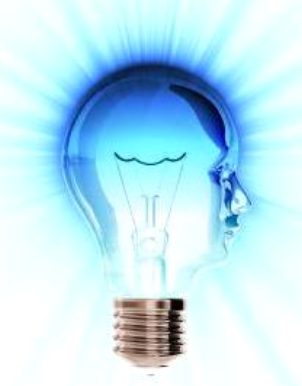
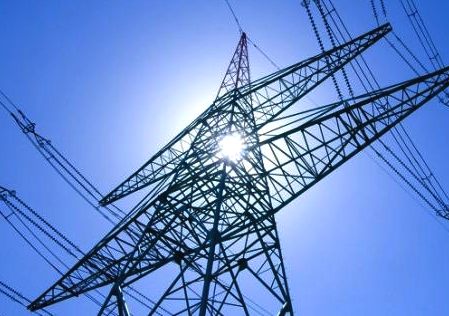
LEFT: A wave containing a lot of kinetic energy CENTER: Using our intelligence to
extract the energy by converting wave motion to pump water, for propulsion or,
RIGHT: to make clean sustainable electricity for our homes, transport and
industry.
Wave energy is the transport of energy by ocean surface waves, and the capture of that
energy to do useful work – for example, electricity generation, water desalination, or the pumping of water (into reservoirs). Machinery able to exploit wave power is generally known as a wave energy converter (WEC).
Wave power is distinct from the diurnal flux of tidal power and the steady gyre of ocean currents. Wave-power generation is not currently a widely employed commercial technology, although there have been attempts to use it since at least
1890. In 2008, the first experimental wave farm was opened in Portugal, at the Aguçadoura Wave Park. The major competitor of wave power is
offshore wind
power.
In fluid dynamics, wind waves or, more precisely, wind-generated waves are surface waves that occur on the free surface of oceans, seas, lakes, rivers, and canals or even on small puddles and ponds. They usually result from the wind blowing over a vast enough stretch of fluid surface. Waves in the oceans can travel thousands of miles before reaching land. Wind waves range in size from small ripples to huge waves over 30 m high.

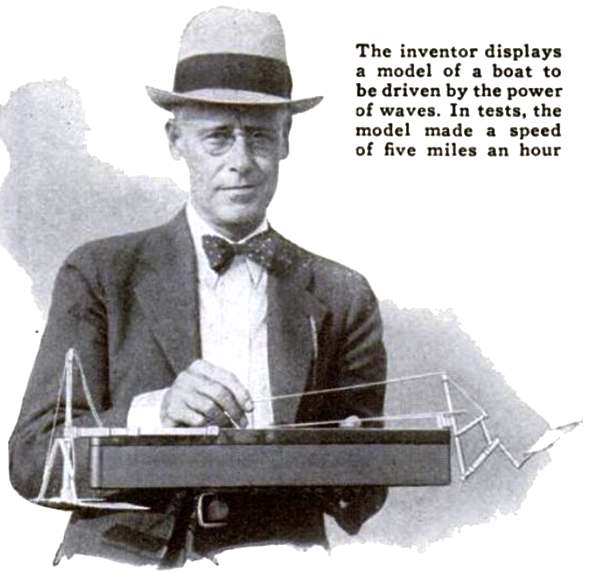
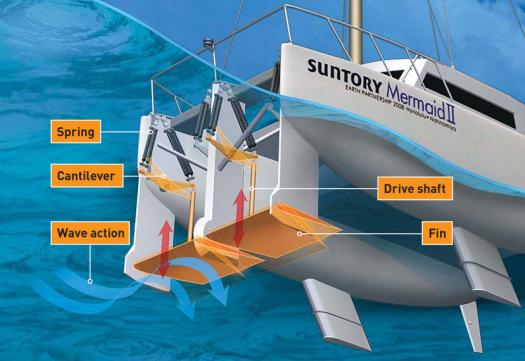
LEFT: Herman Linden's 'Autonaut' Naples, 1895 MIDDLE: Unknown inventor from
Long Beach, CA, shows off his 18" prototype in 1935. Both of these designs
show that the concept of capturing or converting wave energy is not exactly new. The latest developments
though, are exciting in that they are becoming more practical with refinement.
RIGHT: to wit the Suntory Mermaid II from 2010 as a C21 development of the Autonaut
concept.
When directly generated and affected by local winds, a wind wave system is called a wind sea. After the wind ceases to blow, wind waves are called swells. More generally, a swell consists of wind-generated waves that are
not - or are hardly - affected by the local wind at that time. They have been generated elsewhere or some time ago. Wind waves in the ocean are called ocean surface waves.
Wind waves have a certain amount of randomness: subsequent waves differ in height, duration, and shape with limited predictability. They can be described as a stochastic process, in combination with the physics governing their generation, growth, propagation and
decay - as well as governing the interdependence between flow quantities such as: the water surface movements, flow velocities and water pressure. The key statistics of wind waves (both seas and swells) in evolving sea states can be predicted with wind wave models.
Tsunamis are a specific type of wave not caused by wind but by geological effects. In deep water, tsunamis are not visible because they are small in height and very long in wavelength. They may grow to devastating proportions at the coast due to reduced water depth.
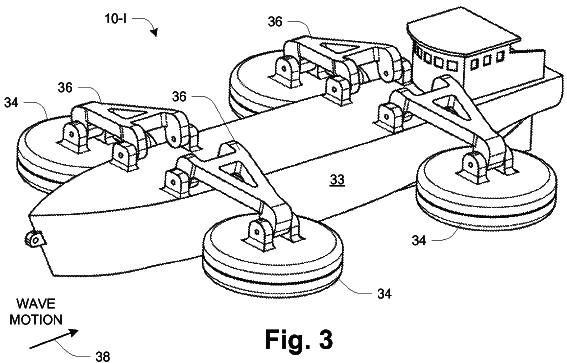
This diagram is from a patent application where the arms on either side of a
barge move with the rise and fall of waves to generate electricity that is
stored onboard the vessel in batteries for later use onshore.
WAVE
MAKING
Waves are generated by wind passing over the surface of the sea. As long as the waves propagate slower than the wind speed just above the waves, there is an energy transfer from the wind to the waves. Both air pressure differences between the upwind and the lee side of a wave crest, as well as friction on the water surface
caused by the wind movement, has the effect of pushing the water which because
it cannot separate (shear stress) causes the growth in height of the waves.
Wave height is determined by wind speed, the duration of time the wind has been blowing, fetch (the distance over which the wind excites the waves) and by the depth and topography of the seafloor (which can focus or disperse the energy of the waves). A given wind speed has a matching practical limit over which time or distance will not produce larger waves. When this limit has been reached the sea is said to be "fully developed".
In general, larger waves are more powerful but wave power is also determined by wave speed, wavelength, and water density.
Oscillatory motion is highest at the surface and diminishes exponentially with depth. However, for standing waves (clapotis) near a reflecting coast, wave energy is also present as pressure oscillations at great depth, producing microseisms. These pressure fluctuations at greater depth are too small to be interesting from the point of view of wave power.
The waves propagate on the ocean surface, and the wave energy is also transported horizontally with the group velocity. The mean transport rate of the wave energy through a vertical plane of unit width, parallel to a wave crest, is called the wave energy flux (or wave power, which must not be confused with the actual power generated by a wave power device).
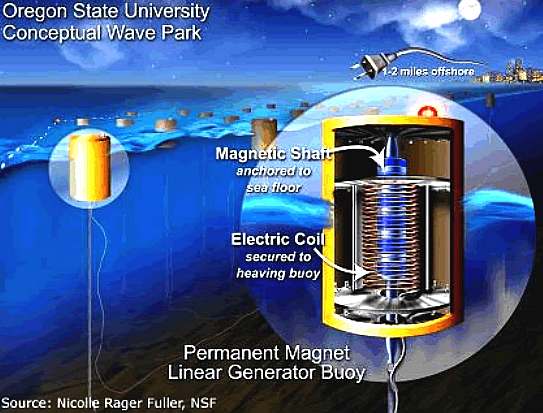

Fleming (of left hand rule fame) would be proud to see this simple method of
generating electricity with a magnet moving up and down inside a coil, or
rather, in this example, a coil moving linearly over a magnet fixed to the sea
bed - simples.
HISTORY
The first known patent to use energy from ocean waves dates back to 1799 and was filed in Paris by Girard and his son. An early application of wave power was a device constructed around 1910 by Bochaux-Praceique to light and power his house at Royan, near Bordeaux in France. It appears that this was the first oscillating water-column type of wave-energy device. From 1855 to 1973 there were already 340
patents filed in the UK alone.
Modern scientific pursuit of wave energy was pioneered by Yoshio Masuda's experiments in the 1940s. He has tested various concepts of wave-energy devices at sea, with several hundred units used to power navigation lights. Among these was the concept of extracting power from the angular motion at the joints of an articulated
raft, which was proposed in the 1950s by Masuda.
A renewed interest in wave energy was motivated by the oil crisis in 1973. A number of university researchers re-examined the potential to generate energy from ocean waves, among whom notably were Stephen Salter from the University of Edinburgh, Kjell Budal and Johannes Falnes from Norwegian Institute of Technology (now merged into Norwegian University of Science and Technology), Michael E. McCormick from
U.S. Naval
Academy, David Evans from Bristol University, Michael French from University of Lancaster, Nick Newman and C. C. Mei from MIT.
Stephen Salter's 1974 invention became known as Salter's duck or nodding duck, although it was officially referred to as the Edinburgh Duck. In small scale controlled tests, the Duck's curved cam-like body can stop 90% of wave motion and can convert 90% of that to electricity giving 81% efficiency.
In the 1980s, as the oil price went down, wave-energy funding was drastically reduced. Nevertheless, a few first-generation prototypes were tested at sea. More recently, following the issue of climate change, there is again a growing interest worldwide for renewable energy, including wave energy.
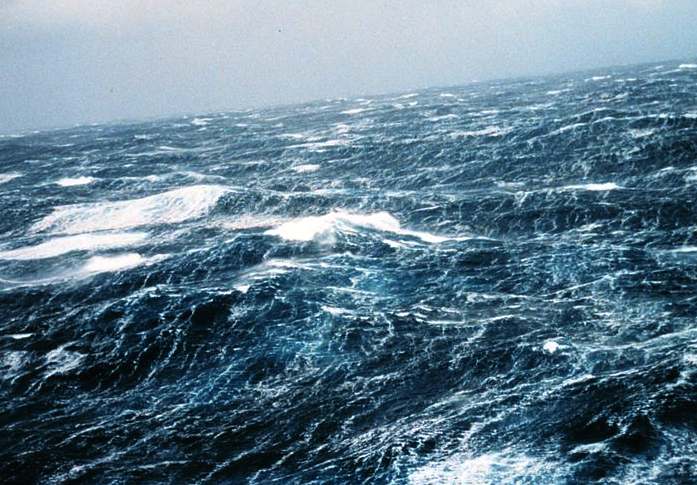
Just another Pacific Ocean storm. Yes, but wave energy is also a huge field of
energy just waiting to be tapped. The fact it is so vast somehow prevents us
thinking about capturing all of that free energy.
TECHNOLOGY
Wave power devices are generally categorized by the method used to capture the energy of the waves, by location and by the power take-off system. Method types are point absorber or buoy; surfacing following or attenuator oriented parallel to the direction of wave propagation; terminator, oriented perpendicular to the direction of wave propagation; oscillating water column; and overtopping. Locations are shoreline, nearshore and offshore. Types of power take-off include: hydraulic ram, elastomeric hose pump, pump-to-shore, hydroelectric turbine, air turbine, and linear electrical generator. Some of these designs incorporate parabolic reflectors as a means of increasing the wave energy at the point of capture. These capture systems use the rise and fall motion of waves to capture energy. Once the wave energy is captured at a wave source, power must be carried to the point of use or to a connection to the electrical grid by transmission power cables.
PROSPECTS
& CHALLENGES
The worldwide resource of wave energy has been estimated to be greater than 2 TW. Locations with the most potential for wave power include the western seaboard of Europe, the northern coast of the UK, and the Pacific coastlines of North and South America, Southern Africa, Australia, and New Zealand. The north and south temperate zones have the best sites for capturing
wave power. The prevailing westerlies in these zones blow strongest in winter.
There is a potential impact on the marine environment. Noise pollution, for example, could have negative impact if not monitored, although the noise and visible impact of each design varies greatly. Other biophysical impacts (flora and fauna, sediment regimes and water column structure and flows) of scaling up the technology is being studied. In terms of socio-economic challenges, wave farms can result in the displacement of commercial and recreational fishermen from productive fishing grounds, can change the pattern of beach sand nourishment, and may represent hazards to safe navigation. Waves generate about 2,700 gigawatts of power. Of those 2,700 gigawatts, only about 500 gigawatts can be captured with the current technology.
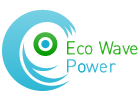
EWP
ECO WAVE POWER
In
another promising version of wave energy capture, Israel's Eco Wave Power (EWP) has
signed a memorandum of understanding agreement with the Ocean University of China
in December of 2012 to fund and test its first commercial scale Wind Clapper and Power Wing wave energy generation system.
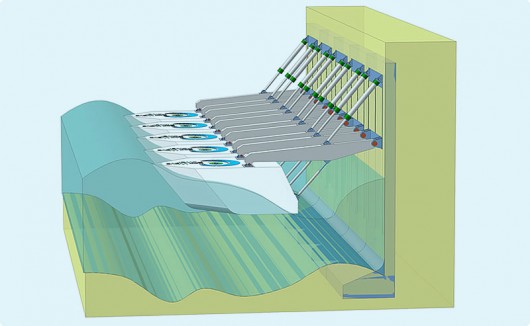
EWP had a busy year in 2012. It began with the construction of a small scale proof-of-concept prototype at the Hydro Mechanic Institute in Kiev, and was followed by a medium scale system installed in the Black Sea during the summer. The company has also recently received the Frost & Sullivan Product Award for the development and implementation of the Wave Clapper and Power Wing wave energy harvesting system.
Unlike offshore wave harvesting systems such as the Pelamis system off the coast of Portugal or AWS Ocean Energy's harvesting device floating on Scotland's Loch Ness, energy from rising and falling waves can be captured close to the shore with EWP's system. Additionally, it can be installed on existing structures like breakwaters, piers, and floating and fixed platforms.

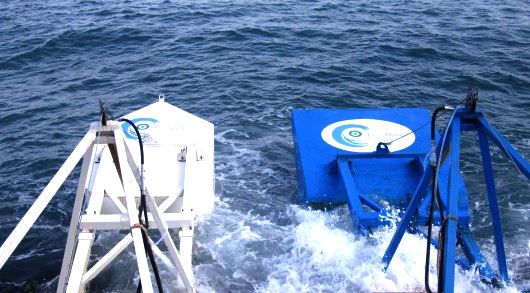

The
system put into action full size and a variation concept drawing where two Eco
Wave generators are placed either side of (straddled) a wind-turbine tower to
capture wave and wind power in one unit.
Now EWP has partnered with the government-owned Ocean University of
China to realize the next phase of the project. According to the terms of the agreement, the university will secure funding for the construction of a commercial-scale development, and then conduct the subsequent research and development work using its state-of-the-art facilities.
"The cooperation between EWP and the Ocean University of
China was made possible thanks to the Road Show to China that was organized by MATIMOP – the Israeli Industry Center for R&D – and the Office of the Chief Scientist at the Ministry of Trade and Labor," said David Leb, founder of Eco Wave Power.
The Road Show took seven Israeli companies to Beijing, Tianjin, Changzhou and Jinan during September
2012 to demonstrate clean energy initiatives.
Eco Wave Power is the sole global inventor, owner and developer of the unique EWP wave energy devices.
Their wave energy company designs, manufactures and operates the EWP wave energy
convertors.
Eco Wave Power is the only wave energy company to
win the Frost & Sullivan Product Innovation Award. According to Frost & Sullivan, "Eco Wave Power efficiently handles the prominent challenges prevailing in the field and offers an all-round solution for effective energy harvesting. Based on the aforementioned performance drivers as measured through Frost & Sullivan independent analysis, Eco Wave Power is the recipient of the 2012 Frost & Sullivan New Product Innovation Award"
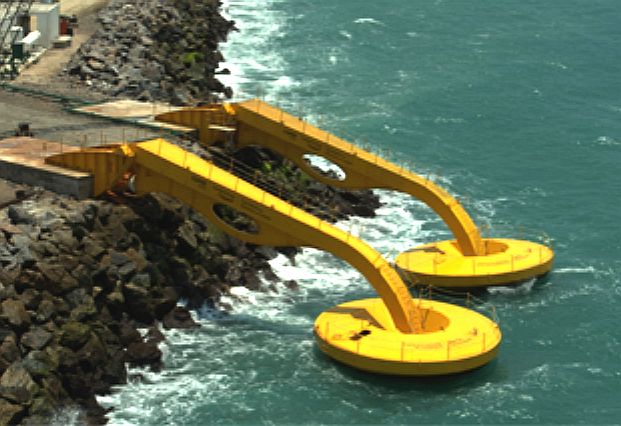

Wave
riding arms on the coast of Brazil, Ceará State - supported by the NAEE
SOUTH
OF BRAZIL OCEAN ELECTRICITY PROJECT
Brazil, with its 8,000 km coastline, has many possibilities to
explore the ocean as a source of clean and renewable energy. One such possibility is emerging in the green seas of Ceará State,
where the first plant in Latin America to harness waves to produce electricity has just been built.
The principle is the same as that used by EWP above, but the design differs
considerably.
Conceived and designed at the Coppe Subsea Technology Laboratory, the plant is located in the port of Pecem, 60 kilometers from
Fortaleza. The project places Brazil among the select group of countries that are testing different technological concepts to
achieve the same goal: to prove that waves are a reliable source of electricity at a viable cost.
According to Professor Estefen Segen, from the Subsea Technology Laboratory of Coppe the differential of the Brazilian technology is
the use of a high pressure system to rotate the turbine and generator; a concept developed and patented by Coppe. A float
connected to the end of a mechanical arm is set in motion by the
waves. This up and down motion activates a pump that pressurizes fresh water stored in an accumulator connected to a hyperbaric
chamber, where the pressure is equivalent to a 200 to 400 meter water column, similar to a hydroelectric plant. The pressurized
water in the form of a jet drives the turbine, which in turn
rotates the generator which produces electricity.
The construction of the Pecém wave plant was financed by the Tractebel Energia SA, through the Program for Research and
Technological Development of the National Agency of Electrical Energy (NAEE), and supported by the government of Ceará.
The potential wave energy in Brazil is estimated at 87 gigawatts. Coppe has evaluated that it is possible to convert about 20% of
this potential into electricity, which is equal to 17% of the total installed capacity in the country today.
BRAZIL
CONTACTS
Wave Pilot Power Plant
Professor Segen Stefen (LTS- COPPE-UFRJ)
Paulo Roberto – paulo@lts.coppe.ufrj.br
(LTS –COPPE- UFRJ)
Andrew ( Coppetec- COPPE- UFRJ)
www.lts.coppe.ufrj.br Suzana Gueiros
gueiros@poli.ufrj.br
gueiros@cos.ufrj.br

So
much energy - not being harvested!

PELAMIS
WAVE POWER - SEA SNAKE
HISTORY - MODEL TESTING 2004
During the first phase of the Pelamis machines' development
before 2004, a range of scale and technology demonstration models were used to understand
performance in extreme waves and verify the accuracy of simulations.
The latest generation of tank test model in use today uses electronic joint control under computer control. This is the primary tool for the analysis of machine response in the very largest seas where no numerical simulations
have captured the full dynamics of extreme waves.
HISTORY - SEA TESTS 2010
The E.ON Pelamis P2 machine,
was first installed at the European Marine Energy Centre (EMEC) in Orkney in October
2010 and is currently undergoing a progressive testing programme. During each installation period the E.ON machine has been generating electricity into the national
grid. The Scottish Power Renewables machine will be tested in parallel with the E.ON machine in a similarly progressive work-up programme.
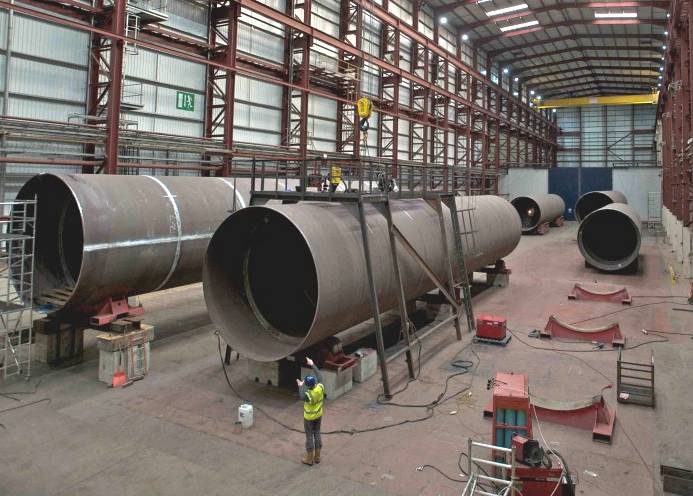
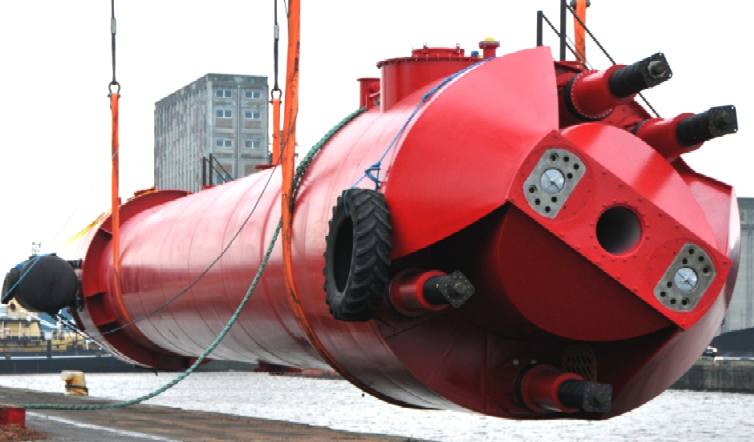
Steel
is rolled into giant tubes and the sections welded. The generating components
are then added, the whole "plug and play" section is painted and then
assembled to form the familiar ocean snake - with bite.
ORKNEYS, SCOTTISH POWER - 2012
This project utilises the existing electrical subsea cables, substation and grid connection at EMEC. The Scottish Government has provided funding for the project through the WATES scheme and consent via Section 36 of the Electricity Act.
The order from
Scottish Power Renewables is the second commercial order for the second generation P2 Pelamis machine and was installed at EMEC
in May 2012. Scottish Power Renewables and E.ON have put in place a unique joint working agreement to
learn from operating and maintaining the machines as a wave farm.
The experience gained from this project will play a vital role in
Scottish Power Renewables' plans to install 66 Pelamis machines in a 50MW project off Marwick Head in Orkney, for which an agreement for lease has been awarded by the Crown Estate.
As a result of
the accelerated testing strategy, the SPR owned Pelamis P2 wave energy converter was able to generate twice the amount of electricity in half the elapsed calendar time, during its initial test parameters of small to medium seas. In deployments since then, the SPR Pelamis machine has experienced larger seas with significant wave heights of up to 5mHs, including individual waves of over 9m. Electricity generation has increased as anticipated in these
larger seas.
The proven average output capability of the device, over the annual spectrum of wave conditions at the EMEC site, is now close to 100kW. Demonstrations of further improvements are anticipated through control optimisation which could double that number as targeted for the next stage of the project.
The machines have now experienced around 90% of sea state occurrences for an average year, allowing the Pelamis team to quantify the performance and electricity output of the P2 machines and gain insight into the factors influencing this. The combined P2 test programme has now accumulated 7500 grid connected operating hours, and exported 160MWh of electricity to the national grid.
This is impressive stuff. The data collected is invaluable. It certainly looks
as though there is a future for wave generation using this technology. As always
the trick is to try things out.
PELAMIS
CONTACTS
Pelamis Wave Power Ltd.
31 Bath Rd, Leith
Edinburgh
EH6 7AH
Scotland. UK
Tel : +44 (0) 131 554 8444
Fax : +44 (0) 131 554 8544
enquiries@pelamiswave.com
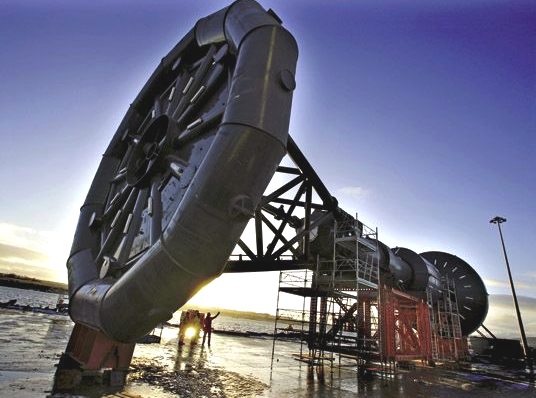
Wave buoy installation, Invergordon, Scotland
SEARAY
- COLUMBIA POWER TECHNOLOGIES & LOCKHEED MARTIN 2013 A
prototype device from called the SeaRay from Columbia Power Technologies could help transform wave energy from a long-running science experiment into the next renewable energy bonanza. “I have never seen a multibillion-dollar market where the customers are literally waiting on the technology,” says Lesemann, a former venture capitalist.
A new government-sponsored study has found that the oceans surrounding the US contain enough energy to potentially supply more than half the nation’s electricity demand. Even with the limits of today’s technology, scientists concluded, there’s sufficient recoverable energy
offshore - some 1,170 tera-watt hours a year in all - to keep a third of the country humming. More energy crashes annually onto the West Coast, for instance, than California uses in a year.
And now the reality check: 5 megawatts. That’s how much electricity - enough to light about 4,000 American
homes - is being currently generated by wave energy worldwide despite years of work by a plethora of start-ups and many millions of dollars in government support, according to research firm Bloomberg New Energy Finance.
What happened? Before the financial crash, the great green tech boom unleashed a rush of startups and speculators staking claims on federal waters to build massive wave farms, while in Europe governments, including Portugal and Scotland, placed big bets on wave energy. But making green off blue power soon proved to be so much California dreaming as plans for West Coast wave energy arrays sank under opposition from surfers, fishermen and local residents.
Even California regulators, who had green-lighted Pacific Gas & Electric’s contract to buy electricity from a solar power station that would orbit the Earth, balked at the utility’s deal with a wave energy start-up, concluding the technology was too risky. And when companies finally began deploying their first wave energy generators in Europe, punishing ocean conditions took their toll as some devices broke down or failed to perform as expected.
“They may work well in prototype in a very small size, but when you scale them they don’t necessarily work as well in a harsh seawater
environment.” Angus McCrone of Bloomberg New Energy Finance is quoted as
saying.
But now the endless wait for that perfect wave generator may be drawing to a close. Thanks to advances in software, a new generation of start-ups like Columbia Power are cheaply and quickly testing hundreds of new designs in virtual oceans while veterans of the industry are perfecting their technology to wring more energy from waves and lower the cost of electricity.
What would we have done without computers? Maybe, just get on with it.
Multinational corporations like Lockheed Martin and Alstom, the French energy giant, have struck partnerships with start-ups to commercialise their technology. “We see wave energy as a very serious market for renewable energy in the future,” says Tim Fuhr, director of ocean energy for Lockheed Martin. “Basically, we see the ocean as the largest untouched source of power on the planet.”
Last September, Lockheed Martin paired with Ocean Power Technologies, a New Jersey company that has spent the better part of two decades developing a device to transform the motion of waves into electricity, accumulating a $120 million deficit along the way. The aerospace conglomerate will help OPT develop a supply chain to industrialise its PowerBuoy wave generator, which is undergoing sea trials in Scotland, for deployment off the Oregon coast this year as part of a 1.5-megawatt wave farm. (Lockheed has a similar partnership with Wave-bob, an Irish wave energy company.) “We have established the survivability of our technology out in the ocean, and we now have a product we can sell commercially,” says Charles Dunleavy, OPT’s chief executive. 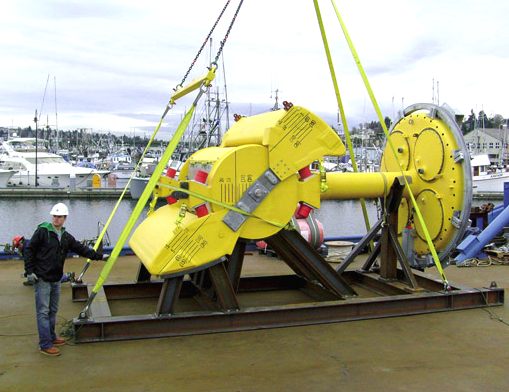
Lockheed
Martin Ltd Reddings Wood, Ampthill, Bedford MK45 2HD
Tel: +44 (0) 1525 841000
|
Ocean
Power Technologies, Inc.
1590 Reed Road
Pennington
New Jersey 08534, USA
Phone: +1 609 730 0400
Fax: +1 609 730 0404
info@oceanpowertech.com
|
Ocean
Power Technologies, Ltd
Warwick
Innovation Centre
Gallows Hill
Warwick CV34 6UW
UK
Phone: +44 (0)1926 623370
info@oceanpowertech.com
|
Ocean
Power Technologies (Australasia) Pty Ltd.
PO
Box 12 Collins Street West
Melbourne
Victoria 3000
Australia
info@optaustralasia.com.au
|
LINKS
& REFERENCE
http://www.coppenario20.coppe.ufrj.br http://forbesindia.com/article/cross-border/power-from-the-waves
21
May 2013 | ScottishPower Renewables Pelamis P2 Machine Celebrates One Year of
Accelerated Real-Sea Testing
7
November 2011 | ScottishPower Renewables’ Pelamis machine arrives in Orkney
14
April 2011 | Pelamis Completes Launch of Second P2 Machine
27
January 2011 | Pelamis project wins TSB investment
8
October 2010 | Phase 1 of Second P2 Moorings Installation Completed
28
March 2010 | PWP Secures Second Order for P2 Machine from ScottishPower
Renewables
http://www.pelamiswave.com
http://www.gizmag.com/ewp-commercial-scale-wave-harvesting-china/25151/
http://www.ecowavepower.com/
http://folk.ntnu.no/eirikbo/wavepropulsion/index
Burnett, R. F. (1979). Wave energy for propelling craft - nothing new. The Naval Architect. Nov. 1979, p. 239.
Dybdahl, K. (1988). Foilpropellen kan revolusjonere skipsfarten. Teknisk Ukeblad/ Teknikk, no. 39, October 1988, pp. 10-11.
Anon.(1983). Wave power for ship propulsion. The Motor Ship, 64(757):67–69.
Berg, A. (1985). Trials with passive foil propulsion on M/S Kystfangst. Project no. 672.138. Technical report, Fiskeriteknologisk Forskningsinstitutt, Fartøyseksjon, Marinteknisk senter, Håkon Håkonsensgt. 34, 7000, Trondheim.
http://www.theengineer.co.uk/engineers-called-on-to-develop-new-low-carbon-ship-propulsion
http://www.newscientist.com/wavepower-ships-could-bring-cheaper-clean-electricity
http://www.wavepropulsion.com/
http://www.boatdesign.net/windmill-wind-turbine-powered-boats-how-many-out-there-they-viable
http://www.forbes.com/2008/06/19/wave-powered-boat-tech-water08-cx_avb_0619waveboat.html
http://atlantic-power-cluster.eu/index.php/en/
http://blog.modernmechanix.com/wind-propeller-sails-proposed-for-liners/
http://en.wikipedia.org/wiki/Rotor_ship
http://www.sailwings.net/art.html
http://www.sailwings.net/rotaryhome.html
http://www.windthrusters.com/
http://www.sailwings.net/
http://www.ecomarinepower.com/wind-and-solar-ships
http://www.seaspeed.co.uk/Trials-and-Testing-Projects/south-boats
http://www.popsci.com/gear-gadgets/article/2008-02/wave-runner
http://www.rexresearch.com/waveboat/waveboat.htm
Ashburton
Guardian (1897). A boat with fins. Volume XVIII, Issue 4281, 30 August
1897.
Bose,
N. and Lien, J. (1990). Energy Absorption from Ocean Waves: In Proc. R. Soc.
Lond, vol.B 240, pp. 591–605.
Fabre,
O. (2008). Japan sailor takes on pacific in wave-powered boat. Reuters,
March 17, 2008. Retrieved June 29, 2011.
Gause,
J. A. (1966). Flexible fin propulsion for vessels GB Patent 1176559. Sept. 7, 1966. Patented Jan. 7,
1970
Gause,
J. A. (1967). Water-borne propulsion system flexible fin members US Patent 3,453,981.
Apr. 24, 1967 Jul 8 1969

DEVELOPMENT: A hybrid, wave, wind and
solar powered vessel with computer controlled
energy harvesting
from nature and a modular SWASH hull design that provides development platforms for both civil and military
applications without having to redesign the whole vessel each time. The system
promises 7-10 knot speeds with zero emissions. This important research is
looking for collaborative partners for the EU Horizon
2020 call in 2014.

|























